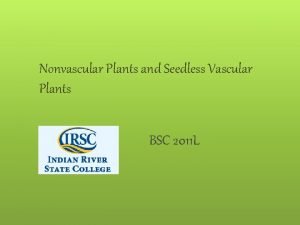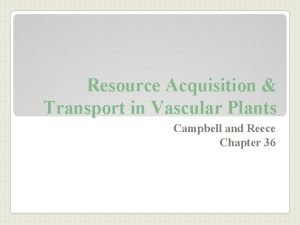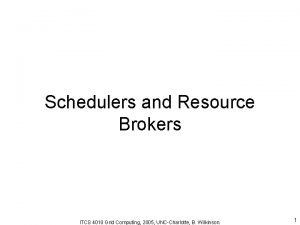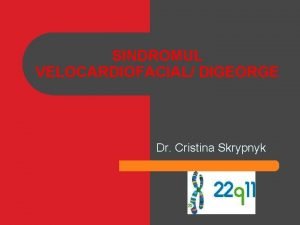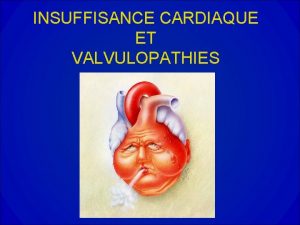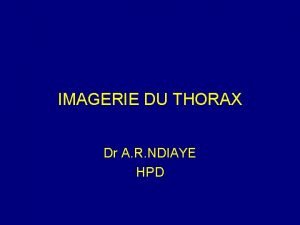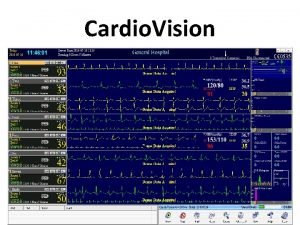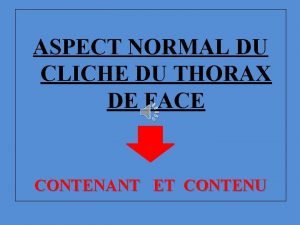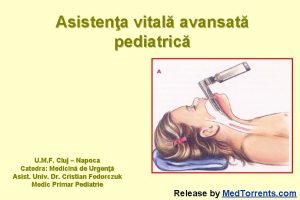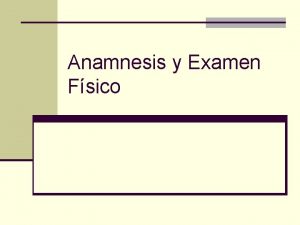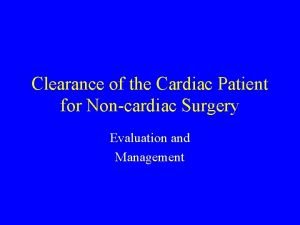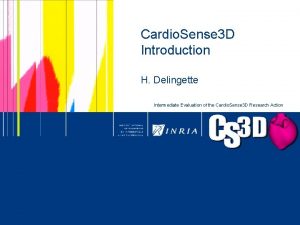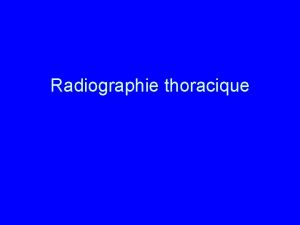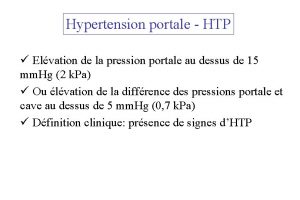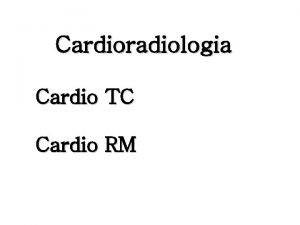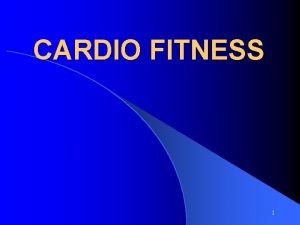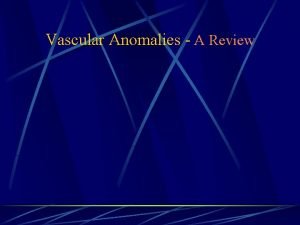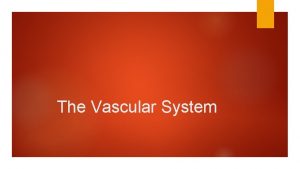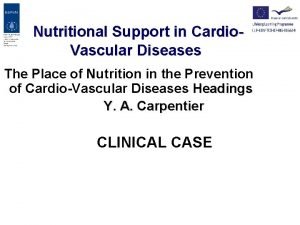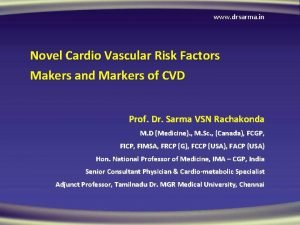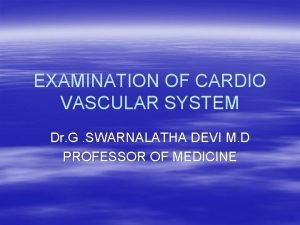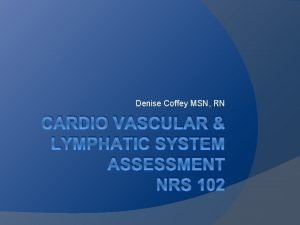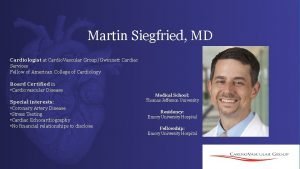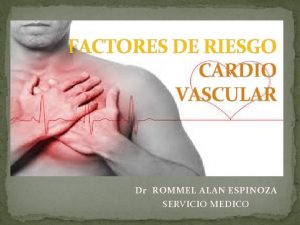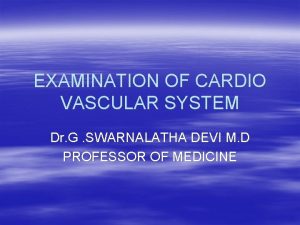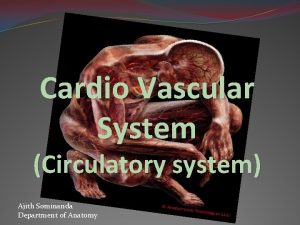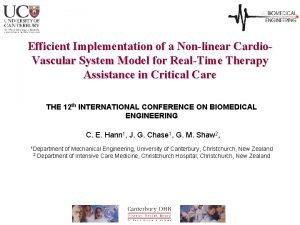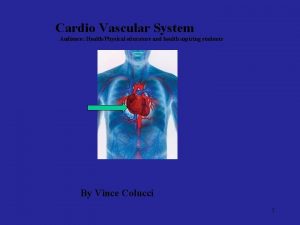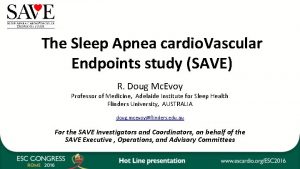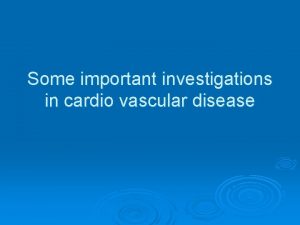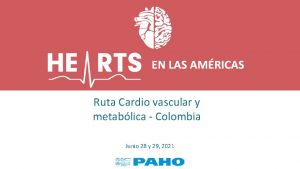The Cardio Vascular Research Grid A Resource Supporting






















- Slides: 22

The Cardio. Vascular Research Grid: A Resource Supporting National Collaborations in Heart Research NHLBI R 24 HL 085343 Raimond L. Winslow The Johns Hopkins University Institute for Computational Medicine

Needs of the CV Community • Need to describe both CV data and data collection methods CV-specific ontologies Semantic description facilitates re-use of data • Need standards-based representation and management of multiscale CV data There are unique CV data types for which no standards exist § Time-evolving EP, ECG, and multi-modal image data • Need to query across multiple types of primary and derived data located and maintained at different sites data federation, federated querying

The Cardio. Vascular Research Grid (CVRG) Project is Addressing These Needs • The CVRG is a community resource for the distributed management, semantic description, federation, and analysis of both primary and derived CV data • CVRG is developing new CV-specific data management resources delivering CV data analysis tools and customized workflows creating easy to use, customized web interfaces for accessing our resources providing these resources in a secure manner

The CVRG Approach to Technology Development • Don’t re-invent the wheel When possible, re-use or extend software components from other Bio. Grid projects (e. g. , ca. BIG and BIRN) • ca. BIG = cancer Biomedical Informatics Grid • BIRN = Biomedical Informatics Research Network • Address the special needs of the CV community Time-evolving imagery ECG and EP data CV-specific vocabularies Integration of multi-scale data sets Specific data analysis workflows • Assure that the CV community drives technology development

CVRG Projects Project 1: The Cardiovascular Research Grid Core Infrastructure (PI: Joel Saltz, Emory) Project 2: Electrophysiological Data Management and Dissemination (PI: Raimond Winslow, JHU) Project 3: Mathematical Characterization of Cardiac Ventricular Anatomic Shape and Motion (PI: Laurent Younes, JHU) Project 4: Grid-Tools for Cardiac Computational Anatomy (PI: Michael Miller, JHU) Project 5: Statistical Learning With Multi-Scale Cardiovascular Data (PI: Donald Geman, JHU) Project 6: Resource Management (PI: Raimond Winslow, JHU)

The CVRG Development Team Johns Hopkins University Emory University Resource PI: Raimond Winslow (rwinslow@jhu. edu) Project PI’s and Investigators: Donald Geman (Machine Learning) Michael Miller (Cardiac CA) Daniel Naiman (Machine Learning) Tilak Ratnanather (Cardiac CA) Raimond Winslow (ECG & EP Services) Laurent Younes (Cardiac CA) Project Manager: Stephen Granite (sgranite@jhu. edu) Project PI’s and Investigators: Joel Saltz (ca. Grid) Tahsin Kurc (ca. Grid) Developers: Mark Grand (Lead Developer) Michel Monsour (Study data) Tony Pan (Imaging) Ashish Sharma (Imaging) Developers: Timothy Brown (Cardiac CA Portal) Bill Gerten (ECG Portal) David Hopkins (Website & Portal) Anthony Kolasny (Cardiac CA Portal) Luan Le (Imaging Portal) Kyle Reynolds (Systems Support) Michael Shipway (Machine Learning Portal) Mathew Toerper (Imaging) ca. Grid Knowledge Center Justin Permar (ca. Grid) Steve Langella (Security) UCSD (BIRN; Yrs 1 -2) Mark Ellisman Jeff Grethe Ramil Manansala

What Data Services Does CVRG Provide? Proteomics Data Service PACS (DCM 4 CHE), DICOM Data Service ECG Data Service Virtual PACS m. RNA Expression Data Service SNP/GWAS Data Service CVRG Portal Portlet Access Federated Querying Study Data Service (Open. Clinica) Developed by CVRG Other CVRG Nodes Developed by NCI-ca. BIG Other Open Source

Grid-enabling Existing Systems Federated Queries CVRG Node 3 (JHU) CVRG Portal Portlet Access Federated Querying Virtual PACS CVRG Node 2 (Emory) ECG Data Service CVRG Node 1 (UCSD) Data Service (“Lighthouse”) ca. Grid Introduce Abstract Model NCI EVS, NCBO Bio. Portal (Terminology, Semantics, Objects, …) PACS 1 PACS 2 Real Database (Oracle, DB 2, …) Managed Locally

What Analysis Services Does CVRG Provide? Heart Shape & Motion Analyses (LDDMM, PTA) Machine Learning; Rweb, ge. Workbench CVRG Portal Workflow Access Other CVRG Nodes ECG Analysis Services

ECG Data Management and Analysis: An Example of Novel Tool Development • Problem ECGs are the most common type of biomedical time-series data Typically, only data derived from ECG analysis is stored Primary data is not always saved When saved, often difficult to collect, may be in image or paper format Data is difficult for clinical researchers to analyze • Challenges: There is no comprehensive data model or database implementation for managing digital ECG data There is no ECG ontology available for use in annotation Few web-based ECG analysis tools • Solution: Develop these resources

ECG Analysis Workflows Reynolds Workflow Norav ECG Data (RDT) ECG Data ECG Analysis Parameters RDT -> HL 7 a. ECG Reynolds ECG Analysis Algorithms Data Storage Services Analytical Services Results Analysis Results Services Physionet Workflow Physionet ECG Data (WFDB – header, data) WFDB ECG Data Metadata XML Physionet ECG Analysis Algorithms Results


CV DICOM Image Data Management: An Example of Re-Use & Extension of ca. BIG Tools • Problem: Imaging (MR, CT, echo, and ultrasound) is becoming increasingly important in the assessment of heart disease. Data often collected at multiple sites, must be shared • Challenges: Images are usually stored as files (not searchable) Local image data are sometimes managed using a PACs It is difficult to manage local PACS client connections to remote PACS Investigators want full control of data access • Solution Use/extend existing image management tools developed in ca. BIG

CV DICOM Image Data Management: Re-use of ca. BIG & Open Source Tools LDDMM/PTA Analysis Workflow 3 DSlicer (Visualization) Seg 3 D (Segmentation) XNAT (Analysis Data) LDDMM/ PTA Analysis DICOM Image Mgmt Workflow PACS (DCM 4 CHE) Virtual PACS Anonymization Indexing Upload Access Privileges Format Conversion PACS Client (KPACS)

Shape and Motion Analysis of Heart Imagery: Re-Use of Data Analysis Tools Developed in the BIRN Brain Morphometry Testbed Beg et al (2004). Computational cardiac anatomy using MRI. Magn. Reson. Med. 52(5): 1167

Statistical Inference on Disease-Induced Heart Shape Changes New Patient Heart H 1 Global Average Heart Hav T(H 1) Hav (preserves dot products and norms) Class 1 = ischemic cardiomyopathy Class 2 = non-ischemic cardiomyopathy Is the transformation T( ) from class 1? If yes, then ischemic cardiomyopathy Else non-ischemic cardiomyopathy

Statistical Inference on Heart Shape (cont. ) septum Ant. Inferior P value Statistically reliable (p=. 008) shape difference in ICM vs NICM Supports classification on novel test data Ardekani et al (2009). Computational method for identifying and quantifying shape features of human left ventricular remodeling. Ann Biomed Eng. 2009; in press.

Statistical Inference on Heart Deformation: Novel Algorithm Development Examine deformation from ED to ES ES (NICM) ES (ICM) Question – Are their deformation differences that discriminate ICM from NICM? Parallel Transport Algorithm PTA) Younes et al (2008). Transport of Relational Structures in Groups of Diffeomorphisms. J. Math. Imaging Vis. 32: 41 -56 Statistically Significant Difference in Wall Thickening From ED to ES PTA Preserves Strain Tensor at Each Image Voxel

Ontologies: • Emerging Strategy • When ontologies/data services are available from ca. BIG, we will use them. These ontologies & services are also available to BIRN • Develop new ontologies that are of special importance in CV research • Cardiovascular Electrophysiology Ontology • Version 1 complete • ECG Ontology • Version 1 nearing completion • Cardiovascular Imaging Ontologies • Beginning stages, with the National Alliance for Medical Image Computing (NAMIC) • Deposit new CV ontologies at the National Center for Biomedical Ontologies (NCBO), and also work to harmonize terms with the NCI Thesaurus/Meta-Thesaurus • These ontologies will then be available for use by BIRN and ca. BIG

Collaboration With the CVRG Project • CVRG Collaboration Proposals (PAR-07 -426, as amended in NOT-08 -103) • Development of a Hypertrophic Cardiomyopathy Consortium (Abraham) • Federation and Analysis of MESA Genetic and Imaging Data Using the CVRG (Lima) • Data Ontologies for Integrating Cardiovascular Epidemiological Studies (Rice) • Final LOI August 21 2009, final proposal submission September 21 2009 • One BRP collaboration proposal submitted • Cardio. Vascular Imaging Informatics (CVRG & NAMIC Collaboration, PI = Kikinis) • NCBO Driving Biological Project • Ontology-Based Annotation of Biomedical Time-Series Data (Winslow) • Physionet (analytic services) • Site beta testers (request account on CVRG portal) • Contact us regarding new DBPs (rwinslow@jhu. edu) • Working Groups, Conference on Cardio. Vascular Informatics

CVRG Web Resources • CVRG Website – Information about the CVRG http: //www. cvrgrid. org/ • CVRG Portal – Web environment for accessing all tools • Link on the CVRG Website • CVRG Wiki – Technical information on all services • • Link on the CVRG Website Software dependencies and revisions Build information Installation instructions

Questions and Discussion
 Vascular vs nonvascular plants
Vascular vs nonvascular plants Nonvascular plants
Nonvascular plants Vascular and non vascular difference
Vascular and non vascular difference Phylloxy
Phylloxy Pga vs lga
Pga vs lga Resource broker in grid computing
Resource broker in grid computing Resource allocation vs resource leveling
Resource allocation vs resource leveling Perbedaan resource loading dan resource leveling
Perbedaan resource loading dan resource leveling Vddi pharmaceuticals
Vddi pharmaceuticals Suportul vital bazal la copii
Suportul vital bazal la copii Sindrom velo cardio facial
Sindrom velo cardio facial Nébilox
Nébilox Signe de convergence hilaire
Signe de convergence hilaire Aortic knob
Aortic knob Cardiovision
Cardiovision Site:slidetodoc.com
Site:slidetodoc.com Cauze reversibile de stop cardio-respirator
Cauze reversibile de stop cardio-respirator Examen físico de ojos ejemplo
Examen físico de ojos ejemplo Cardio clearance meaning
Cardio clearance meaning Cardio sense
Cardio sense Sujet bréviligne
Sujet bréviligne Sufijo fonia ejemplos
Sufijo fonia ejemplos Circulation veineuse collatérale porto cave
Circulation veineuse collatérale porto cave

